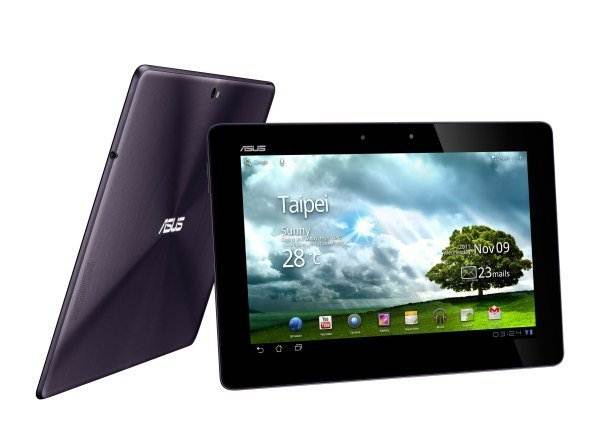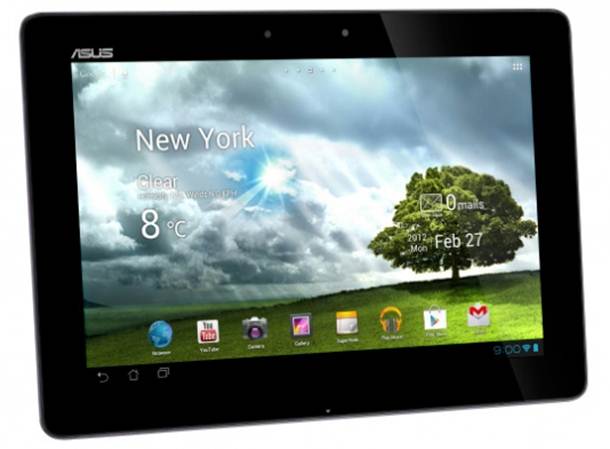Asus Eee Pad Transformer Prime (TF201)

“The screen is by far the best on any
current tablet, with huge viewing angles”
The TF201 was the first tablet on the
market that ran a Tegra 3 chip, which in some small way justified the high
price. Of course, the Nexus 7 means you can get a Tegra 3 for a little over
$242.9, so why would you pay almost $809 for a tablet like this?
The Transformer Prime’s selling point is of
course, the detachable keyboard dock (offered separately). Convertible tablets
offer an excellent experience for work and recreation, and they can fully
replace a laptop in all of the ways that matter – hence the more laptop-style
pricing. However, the specs are also good enough to justify the price, with a
bright 10.1” 1280 x 800 Super IPS+ screen, high-quality 8MP rear camera (with
flash and HD video support), a 1.3MP front camera, and more ports than you can
shake a cable at.
For example, you don’t just get a micro-SD
slot; you also get microHDMI-out, a headphone audio jack, and a docking port
that connects to either the keyboard or a USB interface. The only thing
preventing it from having a full-size USB port is that it’s too thin to
accommodate one comfortably, and we suspect people would prefer this to the
alternative.
The screen is by far the best on any
current tablet, with huge viewing angles. The Super IPS+ mode intended for
outdoor use makes it astonishingly bright, with vibrant and rich colors visible
from any position. That said, if you’re thinking of using it for watching
movies, beware that the audio capabilities of the TF201 are relatively poor and
unusually quiet, with a speaker positioned exactly where you need to put your
hands to hold the device comfortably. A weak design choice.
Although the device ships with the rapidly
aging Honeycomb, it is possible to upgrade to Ice Cream Sandwich. No Jelly Bean
update has been announced, but it’s a definite possibility, if only because
Asus’s ongoing support is superb. Even though the device is eight months old, a
recent firmware upgrade has added new features, including Face Unlock, and this
kind of after-market support is worth paying for.
Still one of the most powerful Android
tablets around
|
Details
|
|
Device class:
|
Tablet
|
|
Price: $
|
807.9 (32GB)
|
|
Android version:
|
Honeycomb (upgradeable to ICS)
|
|
Release date:
|
January 2012
|
|
Features
|
9
|
|
Value
|
7
|
|
Overall
|
8
|
|
|
|
Samsung Galaxy Tab 2
10.1
The Galaxy Tab 10.1 was one of the few on
the market that could directly compete with the iPad 2, but Samsung felt it
could do better. Enter the Galaxy Tab 2 10.1. It’s as thin as the previous
Galaxy Tab 10.1 (thinner than the iPad 2), but now it has a redesigned form, a
micro-SD slot, TV remote control capabilities and it’s substantially cheaper
than its predecessor. It’s hard to argue that it’s improved on its old specs,
but how does it compete against the rest of the market?
The specs are reasonably high, with a 1.2
GHz CPU, 1GB of RAM and 16GB of storage. Although it’s newer and has a
different CPU, benchmarking performance is frequently no better than the Tegra
2 found in the Galaxy Tab 10.1, but since you pay less as well, it’s forgivable
(if not very impressive).
The device is one of a small number actively
designed to be held in widescreen orientation, with speakers at the ‘sides’ and
a front-facing camera halfway up the middle of the longest side. The 10.1”
display is 1280 x 800 resolution with excellent colors and brightness, and
this, combined with the speaker placement, makes it ideal for watching movies
on. The speakers aren’t entirely devoid of the tinny sound common to tablets
and notebooks, but stick in some headphones and it’ll be fine.
Despite being a fairly recent release, the
Galaxy Tab 2 10.1 still runs on Ice Cream Sandwich, and although everyone’s
expecting a Jelly Bean update in due course, there’s no announcement of one
yet, so don’t rely on it appearing. As with all Samsung Android producrs, the
interface is adorned with TouchWiz, Samsung’s favored shell, which helps keep
some unity to the look of its devices and distinguish them from the
competition. Is it better than the standard interface? Not especially, but nor
is it any worse.
The only truly disappointing feature is the
rear camera, which is a frankly disappointing 3MP affair. Far below the
standard of modern devices. Otherwise, it’s an iPad-level Android devcice,
without iPad-level prices.
A reasonably capable and fairly priced
Android alternative to the iPad 2
|
Details
|
|
Device class:
|
Tablet
|
|
Price:
|
$485.5 (16GB)
|
|
Android version:
|
Ice Cream Sandwich
|
|
Release date:
|
May 2012
|
|
Features
|
8
|
|
Value
|
8
|
|
Overall
|
8
|
Asus Eee Pad Transformer Infinity (TF700)

Although it hasn’t yet been released in the
UK, the Asus Eee Pad Transformer Infinity is due to drop any day now – maybe
even by the time you read this! It’s the successor to the Tranformer Prime
TF201, and given the popularity of its predecessor, it’s sure to become a fine
choice for anyone looking to replace their laptop with a tablet rather than
accessorise with one.
With a 1.6GHz Tegra 3 (the fastest tablet
processor to date) and 1GB of RAM, it’s already one of the most powerful
tablets on the market. Available with either 32GB or 64GB of storage, buyers
will find plenty of room for entertainment and apps. The 10.1” 1920 x 1200
resolution display is full HD, has even better brightness and color replication
than the TF201, and even though it’s not quite Retina-quality, it’s one of the
few around that can compete with Apple’s domineering display.
You can expect the price to be high,
although we’re not yet certain what it’ll cost in the UK. Expect prices to be
around $809.5 at least, though, and maybe even closer to $971 depending on
whether you go for the 32GB or 64GB model. Given the cost, you’ll be glad to
know that Asus hasn’t skimped on features – you get a rear 8MP camera, 2MP
front camera (both with HD support), microphone jack, micro-SD, micro-HDMI
ports, and the keyboard docking port. Audio is slightly improved from the
TF201, but still one of the weaker areas, and although it has the same 1GB
memory capacity, it’s DDR3 rather than DDR2
Indeed, there’s little in the TF700 that’s
hugely different form the TF291, but everything’s just that little bit better.
The main upgrade, besides the screen and processor, is the fact that it comes
with Ice Cream Sandwich, and an enjoyably streamlined version of it at that. No
bloatware and only minor interface customization leaves you with a quick,
accessible Android experience. Fans of Jelly Bean will be glad to know that
Asus has committed to an update, although when it’ll emerge is up for debate.
There’s no doubt that if you have the
money, this is an Android tablet worth waiting for. It’s faster, more powerful,
and more capable than any other. With Jelly Bean, it’ll be unstoppable.
Likely to be expensive, but there’ll be no
better tablet around if you can afford it.
|
Details
|
|
Devices class:
|
Tablet
|
|
Price:
|
$tba
|
|
Android version:
|
Ice Cream Sandwich
|
|
Release date:
|
Q3 2012
|
|
Features
|
9
|
|
Value
|
7
|
|
Overall
|
8
|